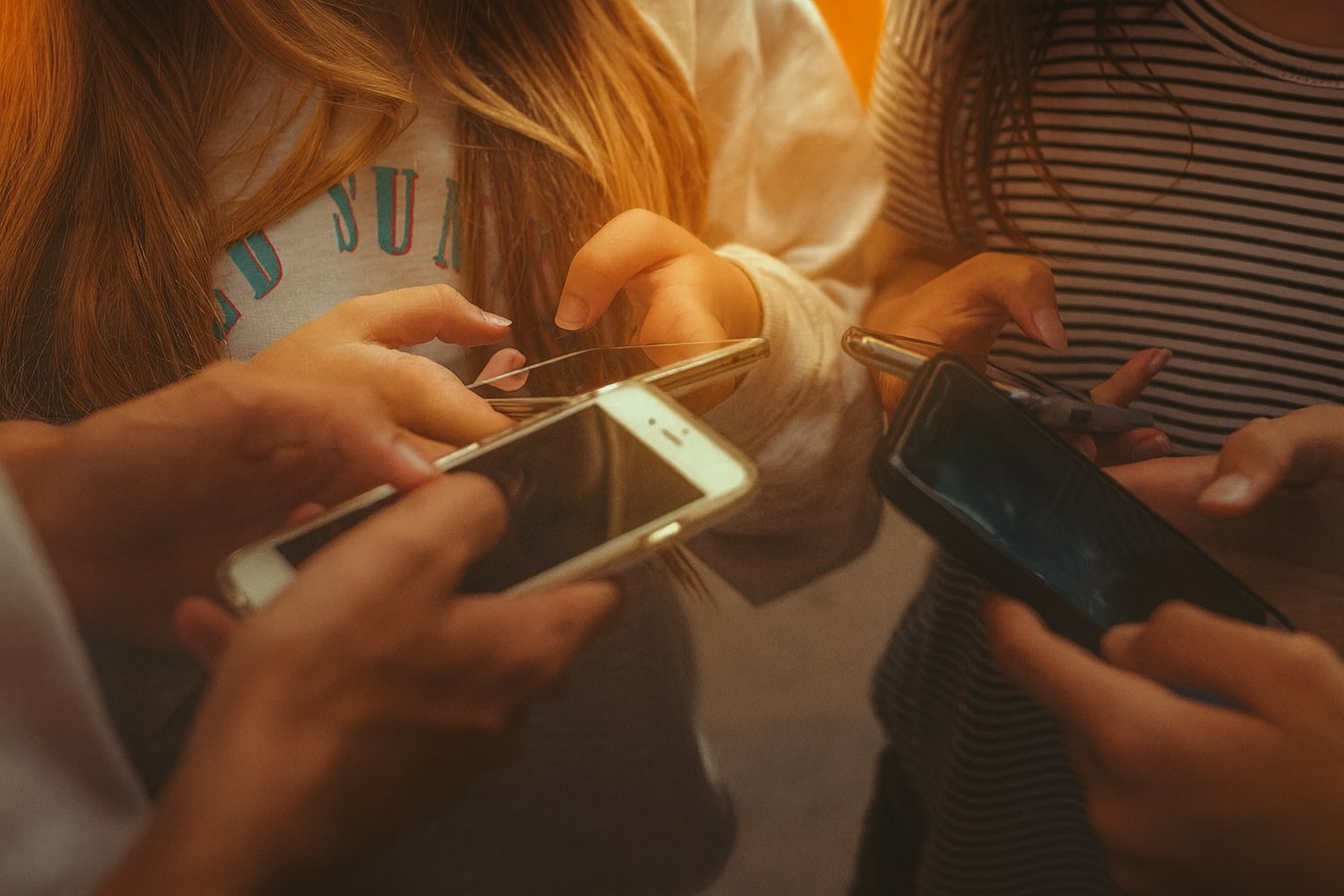- In a Florida district that banned cell phones from bell to bell, student test scores climbed about 2–3 percentile points in year two of the ban [1]. Chalkbeat reports an average gain of ~1.1 percentile (high-use vs low-use schools) [2], which researchers called “meaningful but not game-changing” [3].
- Discipline spiked initially. In the first year of enforcement, suspension rates more than doubled (over 25% higher than before) as schools cracked down on infractions [4]. By year two, suspensions and referrals had fallen back to near-normal [5]. Attendance improved under the ban, and these gains drove roughly half of the score increase [6].
- Better focus, more socializing. Teachers report quieter classrooms and more engaged students. One New York educator noted that without phones “our kids are smarter, more social, and more motivated” [7]. Lunchtime and passing periods are now filled with conversation, fights draw smaller crowds, and cyberbullying has declined [8].
- Nationwide trend. Dozens of states have passed or expanded school phone bans (about 20 states/territories now have outright bans [9], and 26 states have some restriction [10]). For example, a new Ohio law requires all 611 districts to ban phones during the school day by 2026 [11]. New York City even recently extended its ban to cover smartwatches.
- Expert cautions. Economists say phone bans “are not a silver bullet” [12]. The test-score gains were small on average (roughly moving from the 50th to 51st percentile) [13] and were statistically significant mainly for middle schoolers, white and Hispanic students, and boys [14]. Black and female students saw little to no academic lift. Enforcement practices must be fair: researchers noted that Black students faced a higher suspension increase under the ban [15] [16].
Study Results: Score Gains and Discipline
A new working paper from economists David Figlio (Univ. of Rochester) and Umut Özek (RAND) analyzed one large Florida district and found that a strict schoolwide ban did modestly boost performance [17] [18]. In the second year of the ban (2024–25), average test scores in math and reading rose about 2–3 percentile points compared to the pre-ban year [19]. (Figlio estimates this as roughly a 1.1 percentile gain for high-usage schools over low-usage ones [20].) “We’re observing kids attending school more, and they’re performing a bit better on tests,” Figlio told reporters [21]. Chalkbeat quotes him calling the gains “meaningful but not game-changing.” [22]
The researchers caution that the benefits came after a difficult transition. In the first year of enforcement (2023–24), suspension and referral rates spiked dramatically as administrators began confiscating phones and punishing violators [23] [24]. During the first month, suspensions more than doubled, jumping about 25% above pre-ban levels [25]. Many of these penalties initially hit Black boys hardest – Figlio noted a 16% rise in suspensions for Black students [26]. By the second year, however, most schools eased enforcement (e.g. warnings or lighter penalties) and suspension rates returned to normal levels [27] [28]. Notably, student attendance improved under the ban, which the study credits for about half of the academic gains [29]. In short, once students adjusted to the rule, schools saw better focus and slightly higher test scores.
Classroom Environment: Teachers and Students React
Beyond test scores, educators report a noticeably calmer atmosphere. Several teachers told Chalkbeat that removing phones eliminated constant interruptions. As one teacher wrote, without “that Pavlovian vibration derailing their attention every 20 seconds,” students became “smarter, more social, and more motivated.” [30] Lunchrooms and hallways now buzz with face-to-face talk instead of phones. Incidents of cyberbullying and students rushing out to watch fights dropped dramatically [31]. In short, many say learning feels more productive when classes are phone-free.
Experts note this makes sense: phones are inherently distracting. Harvard education professor Martin West testified that while firm proof is hard to get, he’s convinced smartphones are “a key driver of youth mental health challenges, a distraction from learning, and a deterrent to reading.” [32] Removing phones for school hours essentially gives students a mini “digital detox,” letting them concentrate or interact in person. The Florida researchers and other analysts say their data-driven findings support the common-sense hunch: banning phones in class improves focus and on-time attendance [33] [34].
Nationwide Trend: New Policies and Concerns
The Florida study comes as cellphone bans are sweeping the country. Policymakers have largely sided with educators on this issue. ABC News reports about 20 states and territories (including DC and the Virgin Islands) now ban phones and tablets during the school day [35]. In 2025 alone, governors in California, Arkansas, Arizona and others signed new laws limiting in-school phone use [36] [37]. Florida’s 2024 law already bars devices in class and even blocks social media on school Wi-Fi [38]. In Ohio, a new law mandates that by January 2026 every district must implement a comprehensive phone ban [39]. Even New York City’s public schools, which have long restricted phones, have expanded the ban to cover smartwatches.
Much of the momentum comes from concern about youth well-being. In recent years, U.S. officials issued Surgeon General advisories about a teen mental health crisis and the risks of social media, and UNESCO has urged schools worldwide to limit phone use [40]. Supporters of bans argue that by reducing distractions and temptations for cyberbullying or inappropriate browsing, schools can create safer, more focused learning environments. The KFF health policy institute notes, for example, that schools reported improved test scores after banning phones, especially helping students who usually struggle academically [41]. With bipartisan support, many districts now see phone-free classrooms as a low-tech fix for attention and emotional problems.
Cautions and Equity Issues
Experts stress that bans have trade-offs. The Florida study’s authors remind readers that it’s just one district’s data and a draft paper, not a peer-reviewed magic bullet [42]. The results show correlation, not proof that phones caused the score jump [43]. Moreover, gains were uneven: statistically significant improvements appeared mainly for white, male and Hispanic students [44], while Black students and girls saw little academic lift. (Discipline data suggest the initial crackdown may have been harsher on Black students [45] [46].) In fact, researchers note New York City abandoned an earlier cellphone ban partly because lower-income schools were enforcing it more strictly than higher-income ones [47].
Dr. Figlio emphasizes that fair enforcement is key. “Cellphone bans are not a silver bullet,” he says [48]. He worries about the 16% jump in suspensions for Black students in year one, noting it’s unclear whether they violated rules more or were disciplined more severely [49]. Any district adopting a ban needs clear, consistent rules and training so that all students benefit equally. The big takeaway from the research is that phones in classrooms can hurt learning – but banning them requires patience and care. As one expert put it, this may be “a rare case where the data back up the hunches” that unplugging kids in school leads to better outcomes [50], even if the gains are modest and must be balanced against enforcement challenges.
Overall, the evidence so far suggests that students do learn a bit more when phones are locked away, but success depends on how schools handle the change. Administrators and teachers and policymakers are watching these early results closely – balancing the promise of sharper, more focused students [51] against the hurdles of discipline and equity [52] [53]. As more states roll out new phone rules this year, the debate will continue, informed by both hard data and the real-world experiences of classrooms adapting to life without screens.
Sources: Recent reports and studies from Chalkbeat [54] [55], ABC News [56] [57], The Hechinger Report [58] [59], NBC/Channel4 Columbus and KFF Health Policy [60] [61], among others. These sources quote researchers, educators and state officials on school cellphone ban effects and policies.
References
1. abcnews.go.com, 2. www.chalkbeat.org, 3. www.chalkbeat.org, 4. abcnews.go.com, 5. abcnews.go.com, 6. www.chalkbeat.org, 7. www.chalkbeat.org, 8. www.chalkbeat.org, 9. abcnews.go.com, 10. www.chalkbeat.org, 11. www.kff.org, 12. hechingerreport.org, 13. hechingerreport.org, 14. hechingerreport.org, 15. www.chalkbeat.org, 16. hechingerreport.org, 17. abcnews.go.com, 18. www.chalkbeat.org, 19. abcnews.go.com, 20. www.chalkbeat.org, 21. hechingerreport.org, 22. www.chalkbeat.org, 23. abcnews.go.com, 24. hechingerreport.org, 25. abcnews.go.com, 26. hechingerreport.org, 27. abcnews.go.com, 28. hechingerreport.org, 29. www.chalkbeat.org, 30. www.chalkbeat.org, 31. www.chalkbeat.org, 32. www.chalkbeat.org, 33. hechingerreport.org, 34. hechingerreport.org, 35. abcnews.go.com, 36. www.kff.org, 37. www.kff.org, 38. www.kff.org, 39. www.kff.org, 40. www.kff.org, 41. www.kff.org, 42. abcnews.go.com, 43. abcnews.go.com, 44. hechingerreport.org, 45. www.chalkbeat.org, 46. hechingerreport.org, 47. www.kff.org, 48. hechingerreport.org, 49. hechingerreport.org, 50. hechingerreport.org, 51. www.chalkbeat.org, 52. hechingerreport.org, 53. www.kff.org, 54. www.chalkbeat.org, 55. www.chalkbeat.org, 56. abcnews.go.com, 57. abcnews.go.com, 58. hechingerreport.org, 59. hechingerreport.org, 60. www.kff.org, 61. www.kff.org


